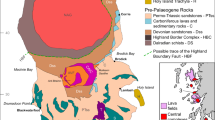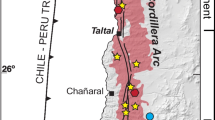Summary
¶The Southern Yenisey Range of Eastern Siberia consists of the granulite facies Kanskiy Complex bordered in the west by the lower-grade Yeniseyskiy and Yukseevskiy Complexes. Three deformational events were recognized in each of the three complexes along the Yenisey River cross-section: a D1 fabric forming event, a D2 shear and folding event, and a D3 shear event. Thrust kinematics across the Southern Yenisey Range suggest that during the D2 event the Kanskiy Complex was thrusted along a regional ductile shear zone onto the lower-grade complexes. This resulted in shearing and folding as well as the development of a dynamic metamorphic zonation. In the low-grade greenstone belt part of the cross section (Yukseevskiy complex) D2 shearing is associated with peak prograde (T ∼ 660 °C and P ∼ 5.8 kbar) metamorphism. The retrograde P-T path of the Yukseevskiy Complex coincides with minimum T of the near-isobaric cooling P-T paths for the adjacent granulites of the Kanskiy Complex (Perchuk et al., 1989). The metamorphism can therefore be attributed to deformation and heat transfer caused by exhumation of the Kanskiy Complex in the time period 2000–1800 Ma which also defines the most significant tectono-thermal event in the Southern Yenisey Range. The tectono-metamorphic pattern and evolution of the low- to high-grade metamorphic complexes of the Southern Yenisey Range is very similar to that described for the ∼ 2600 Ma Limpopo Complex of Southern Africa and the ∼ 1900 Ma Lapland Complex of the Kola Peninsula. Similar geodynamic processes were therefore possibly responsible for the formation of these high-grade terrains suggesting that their formation is linked to a general geodynamic model.
Zusammenfassung
¶Strukturelle und metamorphe Entwicklung des südlichen Jenissei-Gebirges in Ost-Sibirien: Bedeutung für die Platznahme des Kanskiy Granulit-Komplexes
Das südliche Jenissei-Gebirge in Ost-Sibirien besteht aus dem granulit-faziellen Kanskiy Komplex, der im Westen durch die niedrig-gradigen Jenisseiski und Jukseevski-Komplexe begrenzt wird. Drei Deformations-Phasen können in jedem der drei Komplexe längs eines Profiles am Jenissei-Fluss beobachtet werden: Eine Phase, die zur Entwicklung des D1 Gefüges führte, eine Phase D2 mit Scher- und Faltvorgängen und eine D3 Scher-Phase. Die Kinematik von Überschiebungen über das südliche Jenissei-Gebirge deuten an, dass während der D2-Phase der Kanskiy-Komplex längs einer regionalen duktilen Scherzone auf die niedriggradigeren Komplexe überschoben wurde. Dies führte zu Scherung und Faltung, sowie zur Entwicklung einer dynamischen metamorphen Zonierung. In dem niedriggradigen Grünsteingürtel innerhalb des Profils (Jukseevski-Komplex) ist D2-Scherung mit dem Höhepunkt der prograden Metamorphose (T ≈ 660 °C und P ≈ 5,8 kbar) zusammengefallen. Der retrograde P-T-Pfad des Jukseevski-Komplexes fällt mit der Minimum-Temperatur der fast isobaren Abkühlung der P-T-Pfade für die benachbarten Granulite des Kanskiy-Komplexes zusammen (Perchuk et al., 1989). Die Metamorphose kann deshalb auf Deformation und Wärmefluss zurückgeführt werden, die durch die Freilegung des Kanskiy-Komplexes zwischen 2.00 und 1.80 Ma verursacht wurde; letztere fällt auch mit der wichtigsten tektono-thermalen Phase im südlichen Jenissei-Gebirge zusammen. Das tektono-metamorphe Muster und die Entwicklung von niedrig- zu hochgradigen metamorphen Komplexen des südlichen Jenissei-Gebirges ähnelt in vielfältiger Weise dem ungefähr 2.600 Ma alten Limpopo-Komplex im südlichen Afrika und dem 1.900 Ma alten Lappland-Komplex der Kola-Halbinsel. Ähnliche geodynamische Prozesse waren deshalb möglicherweise für die Entstehung dieser hochgradig metamorphen Terrains verantwortlich; dies wiederum weist darauf hin, dass ihre Entstehung einem allgemeinen geodynamischen Modell entspricht.
Similar content being viewed by others
Author information
Authors and Affiliations
Additional information
Received April 27, 1999;/revised version accepted July 14, 1999
Rights and permissions
About this article
Cite this article
Smit, C., Van Reenen, D., Gerya, T. et al. Structural-metamorphic evolution of the Southern Yenisey Range of Eastern Siberia: implications for the emplacement of the Kanskiy granulite Complex. Mineralogy and Petrology 69, 35–67 (2000). https://doi.org/10.1007/s007100050018
Issue Date:
DOI: https://doi.org/10.1007/s007100050018




